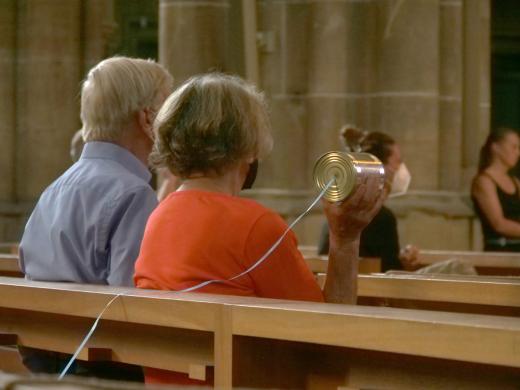Can you hear me
I distribute cleaned tin cans among the audience and connect two of each with a nylon cord. I ask the audience to keep the strings under tension and get in touch with the person on the other side of the cord. Who is listening and who is speaking? How do we coordinate? What do I understand and how do I make myself understood? What do sounds say? What do I say under difficult communication conditions? What do i hear?
A transmitter and a receiver are required for communication. Both sides have to assume both functions for real communication to take place. Can we connect despite the distance and distractions?
The distancing between each other in times of Corona is troubling us. We communicate a lot through digital media. In this performance, which takes place in a church devotional situation, I offer an analog communication system that playfully enables contact despite the required distancing.
Children know the "yoghurt tub telephone" well and the transport of sound waves over a tensioned wire was the forerunner of the first telephones and was used in times of war to convey messages over a distance.
The performance "Can you hear me" is about attentive listening and precise formulation for better communication under difficult conditions. In order to be understood I have to be precise and not overwhelm my counterpart with a torrent of words. In order to understand I have to listen carefully and take enough time to listen until the other person has got his message across. As long as we see each other, we can also communicate via signs, see whether it is our turn or not.
Communication is a mutual giving and taking, an exchange. The more we are present (physically, mentally and spatially), the better we can understand each other.
Therefore, special care is required when dealing with digital communication.
A transmitter and a receiver are required for communication. Both sides have to assume both functions for real communication to take place. Can we connect despite the distance and distractions?
The distancing between each other in times of Corona is troubling us. We communicate a lot through digital media. In this performance, which takes place in a church devotional situation, I offer an analog communication system that playfully enables contact despite the required distancing.
Children know the "yoghurt tub telephone" well and the transport of sound waves over a tensioned wire was the forerunner of the first telephones and was used in times of war to convey messages over a distance.
The performance "Can you hear me" is about attentive listening and precise formulation for better communication under difficult conditions. In order to be understood I have to be precise and not overwhelm my counterpart with a torrent of words. In order to understand I have to listen carefully and take enough time to listen until the other person has got his message across. As long as we see each other, we can also communicate via signs, see whether it is our turn or not.
Communication is a mutual giving and taking, an exchange. The more we are present (physically, mentally and spatially), the better we can understand each other.
Therefore, special care is required when dealing with digital communication.
Tatort- Andacht
St. Paul's Cathedral
Munich
Pics by Saba Bussman,
Klaus Schäfer
St. Paul's Cathedral
Munich
Pics by Saba Bussman,
Klaus Schäfer






















